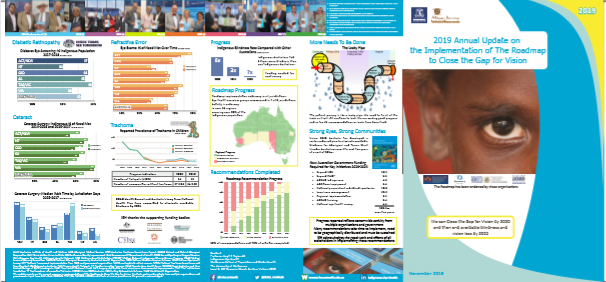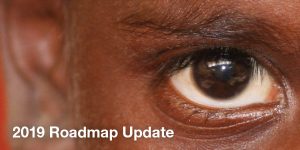1:30min

At today’s 2019 Roadmap Update launch, L-R optometrist Mitchell Anjou AM, Optometry Australia CEO Lyn Brodie and Professor Hugh Taylor AC.
By Helen Carter
Journalist
Half of the systemic issues in Indigenous eyecare have been fixed, according to the 2019 Roadmap Update which confirms Australia remains on track to Close the Gap for Vision for Indigenous Australians by the end of 2020.
However, experts warn that this won’t be achieved without ongoing support for long-term solutions.
Some of the many great achievements, made with the help of optometrists, include outreach eye examinations received by Indigenous Australians nearly tripling in the past six years, and the number of Indigenous Australians with diabetes receiving annual eye examinations for diabetic retinopathy more than doubling in the past 10 years.
Critical to these advances and sustainable long-term solutions is Aboriginal and Torres Strait Islander and community leadership and support.
The 2019 Annual Update on the Implementation of The Roadmap to Close the Gap for Vision was launched today, November 11, 2019, at the Royal Australian and New Zealand College of Ophthalmologists 51th Annual Scientific Congress in Sydney.
President of the Australian Indigenous Doctors Association Dr Kristopher Rallah-Baker launched the update with Professor Hugh Taylor and President-Elect of RANZCO, Dr Heather Mack.
The Roadmap is an initiative of Indigenous Eye Health, in the University of Melbourne and led by Melbourne Laureate Professor and ophthalmologist Hugh Taylor AC. Deputy Director, optometrist Mitchell Anjou AM said the 2019 Update presented further outstanding achievements and progress by the Aboriginal health and eye care sectors.
‘We believe that we are on track to Close the Gap for Vision, but additional government support is required to further expand outreach services and improve co-ordination and access to treatment services and these outcomes need to be measured – hence the advocacy for another national eye health survey in 2020,’ Mr Anjou said.

The 2019 Update highlights that:
- Half of the systemic issues identified in Indigenous eyecare have been fixed with 50 per cent of Roadmap recommendations implemented and 78 per cent of activities completed;
- Activity is underway in more than 55 regions covering over 90 per cent of the Indigenous population;
- Nationwide, 62 per cent of the need for Indigenous eye examinations for refractive error is being met;
- Outreach eye examinations received by Indigenous Australians have almost tripled in the past six years (11,726 in 2011-2012 to 29,161 in 2017-2018, AIHW);
- The number of Indigenous Australians with diabetes receiving annual eye examinations for diabetic retinopathy has more than doubled over the past 10 years, with overall 42 per cent of Indigenous people with diabetes having exams. With 155 retinal cameras being provided to Aboriginal Community Controlled Health Organisations, these rates will keep improving;
- Subsidised schemes are being reviewed and strengthened to improve access to prescription glasses;
- Cataract surgery rates have increased nearly 2.5 times since 2008, but a further 2400 cataract surgeries are required each year to meet the population-based need;
- Indigenous patients still wait 50 per cent longer for cataract surgery in public hospitals, promoting calls for more timely access, resources and case management;
- The Indigenous blindness rate has dropped from six times that of non-Indigenous Australians in 2008 to three times as likely in 2015. A survey in 2020 would determine how much further it has fallen in the past five years.
Nearly eight years since launching his plan to improve the eye health of Indigenous Australians, Professor Taylor said significant advances were also being made to meet the WHO target for the elimination of trachoma in Indigenous communities in Australia by the end of 2020.
Trachoma plummeting
‘We’re making some really good progress and we’ve seen that what’s been recommended and implemented actually works,’ Professor Taylor said. ‘Over the last 10 years, the number of community hotspots for trachoma has reduced from 54 to 13. Trachoma is easily spread between children so ongoing efforts are needed to maintain improvements in hygiene.’
As we approach the final year of the Roadmap, Professor Taylor said steps still need to be taken to guarantee equity by 2020.
‘We have seen an increase in funding and a three-fold increase in outreach of eye services, but to meet community needs we still have another 25 per cent to go,’ he said.
‘The work being done by the Aboriginal and Torres Strait Islander health organisations and all of our partners in eye health has been instrumental in this progress. We cannot overemphasise the importance of linking primary health care with specialist eye health services.
‘Ongoing support is vital to ensuring the expanded services are firmly embedded in the ACCHOs and other primary care providers to make sure that the changes are sustainable over the long term. It will not be possible to Close the Gap for Vision without additional funding.’
Professor Taylor highlighted Vision 2020 Australia initiatives as priority areas for government.
‘Vision 2020 Australia and its members have launched a five-year plan to improve Indigenous eye health. The Strong Eyes, Strong Communities plan calls for $85.5 million to empower ACCHOs, build on our work to Close the Gap for Vision and provide a framework and advocacy program until 2024,’ Professor Taylor said.
This funding would include $18.1 million to expand the Visiting Optometrists Scheme and $10.8 million for a nationally consistent subsidised spectacles scheme.
‘Ongoing reporting and monitoring of progress are of critical importance for maintaining service levels. Funding is urgently required to repeat the National Eye Health Survey in 2020 to gather data and measure the improvement in eye health.’
Optometrists in community settings

Mitchell Anjou AM
Mr Anjou added: ‘Optometrists know that we need to see patients and examine eyes to be able to support improvement of Aboriginal and Torres Strait Islander eye health.
‘Getting out of our practices and into community and community settings is part of this and, pleasingly, the number of people we are examining continues to increase, but still needs to, both in Aboriginal health services, including Aboriginal community-controlled settings, and also in mainstream care.
‘Optometry’s awareness, sensitivity and competence also continues to grow although some challenges remain around establishing culturally safe practices and care.’
The Update reports effective progress through the work of regional stakeholder collectives and networks, supported and overseen by state committees.
‘These structures are critical to allow people contributing to and supporting pathways of care to work together, and we are delighted that optometry and optometrists actively and enthusiastically participate in these approaches across the country,’ Mr Anjou said.
‘The “where to from here?” question is now easy to answer as once the gap is closed, further improvement is required and can be delivered against a goal of eliminating avoidable blindness.
‘This work is framed by Vision 2020 Australia’s Strong Eyes, Strong Communities sector plan for 2019-2024 and the Australian Government’s Long-Term Health Plan to 2025.
‘I am excited to be supporting efforts to enhance optometry’s contribution to Aboriginal and Torres Strait Islander eye care, including embedding eye health into community-controlled health services and the leadership and capacity of Aboriginal and Torres Strait Islander eye care in community.’
The Roadmap is endorsed by Optometry Australia, RANZCO, Vision 2020 Australia and the National Aboriginal Community Controlled Health Organisation.

Tagged as: Indigenous eye health, Patient management, Remote & rural optometry